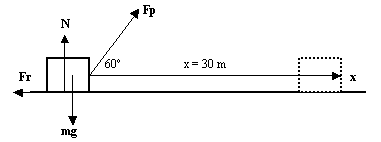Energy Concepts and Definitions-
Energy is one of the most importants concepts
in all physics fields and in other sciences.
The energy has the universal property of being constant. It is not created nor destroyed. Its quantity always remains constant and is never lost; the energy just changes into other forms of energy (heat, light, electricity, etc) with its total quantity balance remaining constant. This explain its importance.
Energy can be defined in a traditional way, although not universally correct, as "the capacity of doing work". This simple definition is not very precise nor valid for all kinds of energy, like energy associated to heat, but it is fully correct for the mechanical energy as described below; that will allow us to understand the close relation between work and energy.
But, what is it understood by work? In daily language has many differents meanings. In Physics has a very precise meaning: to describe what is obtained through the action of a force that moves or displaces over a certain distance.
The work done by a constant force, in magnitude as in direction, is defined as: "the product of the magnitude of displacement with the component of the force parallel to the displacement".
In form of equation:
![]() ,
, where W donotes work,
,
, where W donotes work, ![]() is the component of the force parallel to the net displacement d.
is the component of the force parallel to the net displacement d.
 .
.
In a more general form it is written:
W=Fdcos![]() ,
where F is the magnitude of the constant force, d the object displacement
and
,
where F is the magnitude of the constant force, d the object displacement
and ![]() the angle between
the force and the net displacement. Notice that Fcos
the angle between
the force and the net displacement. Notice that Fcos![]() is precisely the F component parallel to d. Work is
measured in Newton meters, unity that receives the name Joule (J) . 1 J =
1 Nm.
is precisely the F component parallel to d. Work is
measured in Newton meters, unity that receives the name Joule (J) . 1 J =
1 Nm.
Let's see an exercise.
A 40 kg box is dragged 30 m on a horizontal floor, applying a Fp = 100 N exerted by a person. Such force acts doing a 60º angle. The floor exerts a friction force Fr = 20 N. Calculate the work done for each one of these forces Fp, Fr, the weight mg and the normal. Calculate also the net work done on the box.

Solution: There are four forces acting on the box, Fp, Fr, the weight mg and the normal.
The work done by mg and the normal N is
zero, because they are perpendicular to displacement(![]() =90º
for them).
=90º
for them).
The work done by Fp is:
Wp = Fpxcos![]() (using x in place of d) = (100 N)(30 m)cos60º = 1500
J.
(using x in place of d) = (100 N)(30 m)cos60º = 1500
J.
The work done by the friction force Fr is:
Wr = Frxcos180º = (20 N)(30 m)(-1) = -600
J.
The angle between Fr and displacement is 180º because they point in opposite directions.
The net work can be calculated in two equivalents ways:
A moving object has the capability of doing work, and hence it is said it has energy. For instance, a hammer in movement does work on the nail that strikes. In this example, a moving object exerts a force on a second object and moves it a certain distance.
This energy associated to the movement is called Kinetic Energy.
Press this link to access our site on Potential Energy.
Power: See our link on the concept and ilustrations pressing Power
Related Sites:
· Physics,
Main Page
· Physics,
Mathematics
· Physics,
Detailed Homework Scope Help
· Power
· Physics
Problems, Example
· Physics
Homework - Mechanical Energy Conservation Problems
· Physics
Homework - Mechanical Power Problems
· Coulomb's
Law
· Exercises
Using Coulomb's Law
· Electric
Field Charges
· Electric
Field Exercises
· Electric
Potential Energy
· Exercises,
Electric Potential Energy
· Ohm's Law,
Principle
· Ohm's
Law Exercises
· Gauss'
Law
· Gauss'
Law Exercises
· Second
Newton's Law
· Second
Newton's Law Examples, Part One
· Second
Newton's Law Examples, Part Two
· Sound
Waves
· Sound
Waves: Standing, Interference, Doppler Effect - Examples
· Sound
Waves, Doppler Effect - Examples
· Vectors,
Scalars
· Vectors,
Scalars - Analytic Method
· Addition
Vector Tools, Problems
· Free
Fall Theory
· Free
Fall Exercises, Part One
· Free
Fall Exercises, Part Two
· Free
Fall Exercises, Part Three